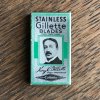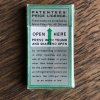- Messages
- 1,529
You are using an out of date browser. It may not display this or other websites correctly.
You should upgrade or use an alternative browser.
You should upgrade or use an alternative browser.
Are these really Stainless?
- Thread starter Bizzyberry
- Start Date
- Messages
- 17,591
- Location
- Sunny Cornwall
I didn't think stainless steel razor blades were made untill 1965 by Wilkinson Sword. Do you have a date for your blades?
- Messages
- 3,671
- Location
- Surrey, UK
Shamelessly lifted from another forum:
Find the full (very long and very interesting) article by Googling the patent number, its the second result.
So stainless blades but uncoated unlike the 1960s WS.
Now we visit the Gillette factory in England on the cusp of WWII, courtesy of Machinery and Production Engineering (London), vol. 53 no. 1357 (1938, p33-38). Since 1927 production has moved from Slough to Isleworth. This happened very recently, ca. 1937. The razors produced are no longer the New Improved and Old Type, but the NEW. The working day appears to be 15 minutes shorter. The factory at Isleworth also produces blades, instead of importing them from Canada as in 1927.
Speaking of blades, compare the process here with that in 1956, still in Isleworth. They seem very similar but soon after 1956 everything would change. First would be the Super Blue Blade, and then serious competition from coated stainless blades ca. 1962. In this 1938 article there is a brief mention of stainless too, but these would have been uncoated blades, probably like the KroMan in the USA....
Find the full (very long and very interesting) article by Googling the patent number, its the second result.
So stainless blades but uncoated unlike the 1960s WS.
The patent is from 1933 and covers blades with a hard cutting edge and a softer centre of the blade to give both sharpness and flexibility. No mention of "stainless" in the patent.
Cheeky how they claim that selling the blades at an 'unauthorised' price constitutes a patent infringement.
Cheeky how they claim that selling the blades at an 'unauthorised' price constitutes a patent infringement.
- Messages
- 1,529
- Thread Starter
- #5
Thanks @Rohleder that is great historical information.
Just found some blades dated 1938 on this site: http://www.mr-razor.com/Rasierklingen/Rasierklingen.htm
I am guessing they were not that good compared to the carbon steel blades of the time. I am not going to open them so their age will remain a mystery.
Just found some blades dated 1938 on this site: http://www.mr-razor.com/Rasierklingen/Rasierklingen.htm
I am guessing they were not that good compared to the carbon steel blades of the time. I am not going to open them so their age will remain a mystery.
- Messages
- 1,529
- Thread Starter
- #6
@jmudrick just posted this over on ATG as I had posted there as well.
"Some of the most interesting plant installed in the factory is used in connection with the manufacture of blades. The blades are not made singly but are produced end-to-end in one long ribbon of steel, the parting-off operation being actually the last performed before final inspection, and being done after hardening, sharpening, and stropping. We may consider here the manufacture of safety blades of the Gillette type. These are made in a variety of designs to suit razors of different patterns, and are usually produced from 1.25 percent carbon steel which includes about 0.3 per cent of chromium. As is well known, ineffective drying of a blade after shaving is the chief cause of the edges losing their keenness. When moisture is allowed to remain on the edges, corrosion sets in very rapidly, with the result that the initial sharpness of the blade is soon destroyed. To offset this, a special brand of Gillette blade is made from stainless steel, and with these blades drying after shaving is unnecessary. Generally speaking a stainless steel blade may be expected to retain the keenness of its edges for a much longer period than a blade of ordinary steel"
Machinery and Production Engineering (London), vol. 53 no. 1357 (1938, p33-38
"Some of the most interesting plant installed in the factory is used in connection with the manufacture of blades. The blades are not made singly but are produced end-to-end in one long ribbon of steel, the parting-off operation being actually the last performed before final inspection, and being done after hardening, sharpening, and stropping. We may consider here the manufacture of safety blades of the Gillette type. These are made in a variety of designs to suit razors of different patterns, and are usually produced from 1.25 percent carbon steel which includes about 0.3 per cent of chromium. As is well known, ineffective drying of a blade after shaving is the chief cause of the edges losing their keenness. When moisture is allowed to remain on the edges, corrosion sets in very rapidly, with the result that the initial sharpness of the blade is soon destroyed. To offset this, a special brand of Gillette blade is made from stainless steel, and with these blades drying after shaving is unnecessary. Generally speaking a stainless steel blade may be expected to retain the keenness of its edges for a much longer period than a blade of ordinary steel"
Machinery and Production Engineering (London), vol. 53 no. 1357 (1938, p33-38
- Messages
- 7,011
...Cheeky how they claim that selling the blades at an 'unauthorised' price constitutes a patent infringement.
http://www.cpcstrategy.com/blog/2015/05/minimum-advertised-price-map-violation-amazon/
- Messages
- 52
Does it say "stainless steel" anywhere on packaging?
I see "stainless", but not "stainless steel".
I see "stainless", but not "stainless steel".
Thankfully these sort of arrangements are usually illegal this side of the pond: https://www.gov.uk/government/publi...resale-price-maintenance-advice-for-retailers
- Messages
- 7,011
Thankfully these sort of arrangements are usually illegal this side of the pond: https://www.gov.uk/government/publi...resale-price-maintenance-advice-for-retailers
It helps protect a product's "branding" and also does not cause smaller retailers to be screwed by the "Big Box" retailers who can survive a finer profit margin.
- Messages
- 52
Price fixing, either way. Consumers lose the most, either way. A certain brush manufacturer has such agreement, if I am not mistaken.
- Messages
- 7,011
Price fixing, either way. Consumers lose the most, either way. A certain brush manufacturer has such agreement, if I am not mistaken.
That's just what a buddy of mine said.........right before they "offshored" his job.
- Messages
- 120
- Location
- Arkansas USA
Try the Treet carbon black & you will never go back.
- Messages
- 1,529
- Thread Starter
- #14
I have and I like them.Try the Treet carbon black & you will never go back.


